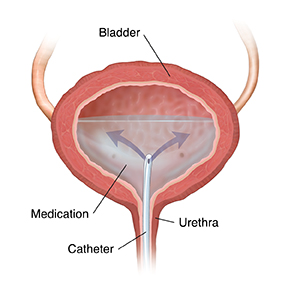Treating Interstitial Cystitis: Medicine
Interstitial cystitis is a painful condition of the bladder. People with interstitial cystitis have a bladder wall that is tender and easily irritated. This leads to uncomfortable symptoms. Interstitial cystitis is ongoing (chronic). This means it has no cure. But it can be managed to help you feel better. Many types of treatment can help manage symptoms and pain. Some may work well for one person and not for another. More than one treatment may be tried so your healthcare provider can find what works best for you.
Oral medicines
Your healthcare provider may give you one or more of these. Ask your healthcare provider about all of your options.
-
Pain medicine. These may be used for a short time to help ease discomfort.
-
Antispasmodic medicines. These may help relax the bladder muscles. This may decrease the need to urinate.
-
Nonsteroidal anti-inflammatory drugs (NSAIDs). These may help reduce inflammation and ease pain.
-
Antihistamines. These may help reduce inflammation and ease pain.
-
Antidepressants. In low doses, these may block pain and help ease symptoms.
-
Pentosan polysulfate sodium and similar medicines. These can restore the bladder lining.
Bladder instillation
Bladder instillation is also called bladder wash, bath, or cocktail. It may help ease your inflammation. It may help repair the bladder’s lining. During the treatment, the bladder is filled with liquid medicine. This is done with a thin tube (catheter). One or more types of medicine may be used. You will hold the medicine in your bladder for 15 to 30 minutes. Then you will urinate. Or the medicine is drained out through the catheter. This treatment is repeated over 2 to 3 months. In some cases, treatment may be done at home.

Bladder hydrodistention
Hydrodistention is a procedure to stretch the walls of the bladder. It's done by filling the bladder with fluid. You may have had this procedure to diagnose your interstitial cystitis. Some people have relief from symptoms for a time afterward.
Online Medical Reviewer:
Marc Greenstein MD
Online Medical Reviewer:
Raymond Kent Turley BSN MSN RN
Online Medical Reviewer:
Tennille Dozier RN BSN RDMS
Date Last Reviewed:
5/1/2022
© 2000-2024 The StayWell Company, LLC. All rights reserved. This information is not intended as a substitute for professional medical care. Always follow your healthcare professional's instructions.